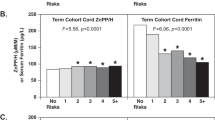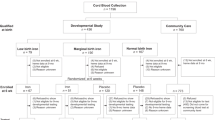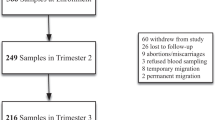Abstract
Background/objectives:
Preterm infants are at risk of iron deficiency (ID). In the Netherlands, preterm infants born after 32 weeks of gestational age (GA) do not receive iron supplementation on a routine basis. We hypothesized that dietary iron intake in these infants might not be sufficient to meet the high iron requirements during the first 6 months of life.
Subjects/methods:
In a prospective cohort study, we analyzed the prevalence and risk factors of ID in 143 infants born between 32+0 and 36+6 weeks GA who did not receive iron supplementation.
Results:
ID at the age of 4 and 6 months was present in 27 (18.9%) and 7 (4.9%) infants. Results of a multivariable logistic regression analysis showed that ID was associated with lower birth weight, a shorter duration of formula feeding, more weight gain in the first 6 months of life and lower ferritin concentrations at the age of 1 week.
Conclusions:
Preterm infants born after 32 weeks GA have an increased risk of ID compared with those born at term, supporting the need of iron supplementation. Our results suggests that measurement of ferritin at the age of 1 week might be useful to identify those infants at particular risk and could be used in populations without general supplementation programs. However, the efficacy and safety of individualized iron supplementation, based on ferritin concentrations at the age of 1 week, together with other predictors of ID, needs to be further investigated, preferably in a randomized controlled trial.
This is a preview of subscription content, access via your institution
Access options
Subscribe to this journal
Receive 12 print issues and online access
$259.00 per year
only $21.58 per issue
Buy this article
- Purchase on Springer Link
- Instant access to full article PDF
Prices may be subject to local taxes which are calculated during checkout



Similar content being viewed by others
References
Domellof M, Braegger C, Campoy C, Colomb V, Decsi T, Fewtrell M et al. Iron requirements of infants and toddlers. J Pediatr Gastroenterol Nutr 2014; 58: 119–129.
Lozoff B . Iron deficiency and child development. Food Nutr Bull 2007; 28: S560–S571.
Rao R, Georgieff MK . Iron therapy for preterm infants. Clin Perinatol 2009; 36: 27–42.
Perrone S, Tataranno L, Stazzoni G, Ramenghi L, Buonocore G . Brain susceptibility to oxidative stress in the perinatal period. J Matern Fetal Neonatal Med 2013; e-pub ahead of print 23 August 2013.
Baker RD, Greer FR . Diagnosis and prevention of iron deficiency and iron-deficiency anemia in infants and young children (0-3 years of age). Pediatrics 2010; 126: 1040–1050.
Agostoni C, Buonocore G, Carnielli VP, De Curtis M, Darmaun D, Decsi T et al. Enteral nutrient supply for preterm infants: commentary from the European Society of Paediatric Gastroenterology, Hepatology and Nutrition Committee on Nutrition. J Pediatr Gastroenterol Nutr 2010; 50: 85–91.
Franz AR, Mihatsch WA, Sander S, Kron M, Pohlandt F . Prospective randomized trial of early versus late enteral iron supplementation in infants with a birth weight of less than 1301 grams. Pediatrics 2000; 106: 700–706.
World Health Organization Assessing the iron status of populations. Version 2 2007. http://www.who.int/nutrition/publications/micronutrients/anaemia_iron_deficiency/9789241596107/en/. Accessed July 2014.
Domellof M . Iron requirements in infancy. Ann Nutr Metab 2011; 59: 59–63.
Schonbeck Y, Talma H, van Dommelen P, Bakker B, Buitendeijk SE, HiraSing RA et al. The world's tallest nation has stopped growing taller: the height of Dutch children from 1955 to 2009. Pediatr Res 2013; 73: 371–377.
Dewey KG, Domellof M, Cohen RJ, Landa Rivera L, Hernell O, Lonnerdal B . Iron supplementation affects growth and morbidity of breast-fed infants: results of a randomized trial in Sweden and Honduras. J Nutr 2002; 132: 3249–3255.
McDonald SJ, Middleton P, Dowswell T, Morris PS . Effect of timing of umbilical cord clamping of term infants on maternal and neonatal outcomes. Cochrane Database Syst Rev 2013; 7: CD004074.
Knol FA, Van Hoog naar laag; van laag naar hoog. 1998. http://www.scp.nl/Publicaties/Alle_publicaties/Publicaties_1998/Van_hoog_naar_laag_van_laag_naar_hoog. Accessed July 2014.
Knol FA, Statusontwikkeling van wijken in Nederland 1998-2000. 2003. www.scp.nl/dsresource?objectid=21003&type=org. Accessed July 2014.
Schiza V, Giapros V, Pantou K, Theocharis P, Challa A, Andronikou S . Serum transferrin receptor, ferritin, and reticulocyte maturity indices during the first year of life in 'large' preterm infants. Eur J Haematol 2007; 79: 439–446.
Verweij A, Sanders C, van der Lucht F, FRJ den Hartog, Scholing en opleiding: wat is de huidige situatie? 2014. http://www.nationaalkompas.nl/bevolking/sociaaleconomische-status/wat-is-sociaaleconomische-status/. Accessed July 2014.
Centraal Bureau voor de Statistiek. Migratie; land van herkomst/vestiging, geboorteland en geslacht. 2013. http://statline.cbs.nl/StatWeb/publication/?VW=T&DM=SLNL&PA=60032&LA=NL. Accessed July 2014.
Hay G, Sandstad B, Whitelaw A, Borch-Iohnsen B . Iron status in a group of Norwegian children aged 6-24 months. Acta Paediatr 2004; 93: 592–598.
Berglund S, Westrup B, Domellof M . Iron supplements reduce the risk of iron deficiency anemia in marginally low birth weight infants. Pediatrics 2010; 126: e874–e883.
van de Lagemaat M, Amesz E, Schaafsma A, Lafeber H . Iron deficiency and anemia in iron-fortified formula and human milk-fed preterm infants until 6 months post-term. Eur J Nutr 2013; 53: 1263–1271.
Meinzen-Derr JK, Guerrero ML, Altaye M, Ortega-Gallegos H, Ruiz-Palacios GM, Morrow AL . Risk of infant anemia is associated with exclusive breast-feeding and maternal anemia in a Mexican cohort. J Nutr 2006; 136: 452–458.
Friel JK, Aziz K, Andrews WL, Serfass RE . Iron absorption and oxidant stress during erythropoietin therapy in very low birth weight premature infants: a cohort study. BMC Pediatr 2005; 5: 29.
Braekke K, Bechensteen AG, Halvorsen BL, Blomhoff R, Haaland K, Staff AC . Oxidative stress markers and antioxidant status after oral iron supplementation to very low birth weight infants. J Pediatr 2007; 151: 23–28.
Idjradinata P, Watkins WE, Pollitt E . Adverse effect of iron supplementation on weight gain of iron-replete young children. Lancet 1994; 343: 1252–1254.
Steinmacher J, Pohlandt F, Bode H, Sander S, Kron M, Franz AR . Randomized trial of early versus late enteral iron supplementation in infants with a birth weight of less than 1301 grams: neurocognitive development at 5.3 years' corrected age. Pediatrics 2007; 120: 538–546.
Makela E, Takala TI, Suominen P, Matomäki J, Salmi TT, Rajamäki A et al. Hematological parameters in preterm infants from birth to 16 weeks of age with reference to iron balance. Clin Chem Lab Med 2008; 46: 551–557.
Acknowledgements
Nutricia BV (Utrecht, the Netherlands) provided financial support for the laboratory measurements described in this study. Nutricia had no role in the study design, analysis or interpretation of the data, writing the manuscript or the decision to submit the paper for publication.
Author information
Authors and Affiliations
Corresponding author
Ethics declarations
Competing interests
The authors declare no conflict of interest.
Rights and permissions
About this article
Cite this article
Uijterschout, L., Domellöf, M., Abbink, M. et al. Iron deficiency in the first 6 months of age in infants born between 32 and 37 weeks of gestational age. Eur J Clin Nutr 69, 598–602 (2015). https://doi.org/10.1038/ejcn.2014.217
Received:
Accepted:
Published:
Issue Date:
DOI: https://doi.org/10.1038/ejcn.2014.217
This article is cited by
-
Zinc protoporphyrin/heme ratio as parameter of iron status in moderately preterm infants: natural course and associations in the first 4 months
Journal of Perinatology (2017)
-
Predictive factors of iron depletion in late preterm infants at the postnatal age of 6 weeks
European Journal of Clinical Nutrition (2016)
-
Serum hepcidin in infants born after 32 to 37 wk of gestational age
Pediatric Research (2016)
-
Asthma as a disruption in iron homeostasis
BioMetals (2016)



